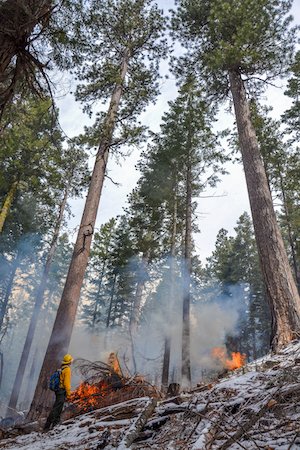Forest Service 10-year Wildfire Strategy
The US Forest Service recently announced a 10-year, multibillion-dollar plan to reduce wildfire risk on up to 50 million acres that border vulnerable communities throughout the country.
The initiative, called “Confronting the Wildfire Crisis: A Strategy for Protecting Communities and Improving Resilience in America’s Forests,” aims to reduce the danger of catastrophic fires by thinning forests and using controlled burns to remove flammable vegetation.
Under the 10-year strategy, the Forest Service will allocate additional investments to communities throughout the West, where wildfire risk to homes and communities is highest. The strategy highlights new research on priority high-risk “firesheds” – large, forested landscapes with a high likelihood that an ignition could expose communities and infrastructure to wildfire. The plan identifies six high-risk firesheds in southwest Oregon surrounding the communities of Merlin and the Illinois Valley and two in northern California surrounding the communities of Hornbrook and Yreka.
The Forest Service plans to dramatically increase fuels and forest health treatments by up to four times current treatment levels starting with high-priority firesheds. The strategy calls for the Service to treat up to an additional 20 million acres on National Forests and grasslands and support treatment of up to an additional 30 million acres of other federal, state, Tribal, private and family forest lands.
These treatments are estimated to cost $50 billion, only some of which is secured. In addition to Forest Service funding, the recent Infrastructure Investment and Jobs Act will fund $3.4 billion over the next five years of the strategy.
KS Wild’s Analysis
While the plan uses many buzzwords like “paradigm shift,” the strategy is still heavily focused on fighting fire instead of working with fires when they naturally ignite. The Forest Service and fire fighting partners have failed at the old tactics of trying to prevent every fire instead of creating new strategies on how to work and live with fire. They have also failed by not using nearly enough controlled fire when conditions are safe, ensuring that the fires we do get are under the worst possible conditions to control.
Some fires, under certain conditions, are not threatening communities and are doing good work to restore forest structure. We need to begin working with these fires and even lighting some fires when we can predict good conditions. Fire has been used as a tool for millennia by Indegious Peoples to manage landscapes and to guarantee food sovereignty. Engaging with tribes on how and where to apply controlled burns will better prepare our forests and communities for the next wildfire.
The strategy lays out plans to increase fuel treatments by up to four times the current pace. Though most of the priority areas are in the wildland-urban interface and not in the backcountry, we are still concerned about the scale and type of management practices such as logging. The report does not lay out specific details about the intensity of these treatments.
The 10-year strategy brings in necessary and additional funding to the wildfire crises of the West. What is lacking is a different approach to how the Forest Service manages fire on the landscape.
Old-growth forest protections
The strategy also lays out ways in which the Forest Service plans to protect old-growth forests potentially threatened by wildfire. This includes creating maps to identify areas of high wildfire risk old-growth forests which will then be used in project planning and decision making.
Throughout the West, our forests and wildlands are part of a natural solution to climate change. By protecting our old-growth forests, we can increase our forests' natural capacity to capture and store carbon. KS Wild will be tracking projects throughout the region to make sure climate-smart management practices are implemented.
Click here to read the 10-year strategy and implementation plan.

